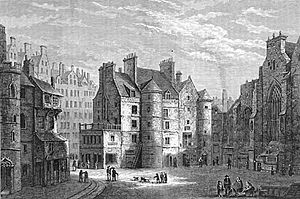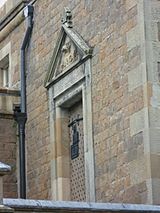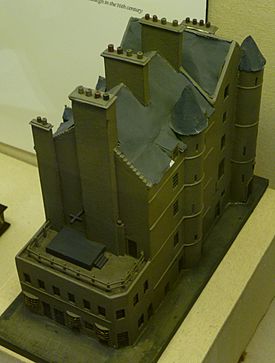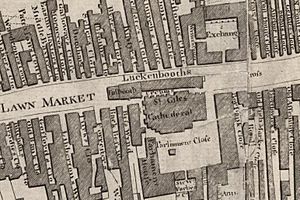Old Tolbooth, Edinburgh facts for kids
Quick facts for kids Old Tolbooth, Edinburgh |
|
|---|---|
 |
|
| Former names | Pretorium Burgi |
| General information | |
| Type | Municipal building |
| Architectural style | Scottish Medieval |
| Location | High Street |
| Town or city | Edinburgh |
| Country | Scotland |
| Coordinates | 55°56′57.95″N 3°11′30.21″W / 55.9494306°N 3.1917250°W |
| Construction started | 1386 |
| Completed | c. 1400 |
| Renovated | 1561 |
| Demolished | 1817 |
The Old Tolbooth was an important municipal building in the city of Edinburgh, Scotland for more than 400 years. The medieval structure, which was located at the northwest corner of St Giles' Cathedral and was attached to the west end of the Luckenbooths on the High Street in the Old Town, was first established in the 14th century by royal charter. Over the years it served a variety of purposes such as housing the Burgh Council, early meetings of the Parliament of Scotland and the Court of Session. The Tolbooth was also the burgh's main jail where, in addition to incarceration, physical punishment and torture were routinely conducted. From 1785 public executions were carried out. In 1817 the buildings, which had been rebuilt and renovated several times, were demolished.
Contents
History
A deed in the chartulary of St Giles' Cathedral indicates there was already a pretorium (an earlier Latin term for a tolbooth) in Edinburgh as early as 1368. Following the burnings of Edinburgh by Edward II of England in 1323 and his son, Edward III, in 1335 during the Wars of Scottish Independence and again in 1385 when Richard II of England burned the town, major rebuilding and improvements were required. In 1386, Robert II granted Edinburgh a charter which gave the burgh an area of land 60 feet (18 m) by 30 feet (9.1 m) in the market place with licence to develop the site for the ornament and use of the city. The charter, written in Latin, was endorsed "Carta fundi de la Belhous" (English: Charter of the site of the Belhous), signifying the purpose of the site for a new Belhouse, successor to the earlier pretorium, and may be translated:
Know ye, that we have given, granted, and by this our present charter have confirmed, to our beloved and faithful, the Burgesses and Community of Edinburgh, and their successors in time to come, 60 feet in length and 30 feet in breadth of land lying in the market place of the said burgh, on the north side of the street thereof; giving and granting to them, and their foresaid successors, our special license to construct and erect houses and buildings on the foresaid land, for the ornament of the said burgh, and for their necessary use.
There is no record of construction on the site but, on 3 October 1403, the earliest burgh record mentions the "Pretorio burgi" - the Pretorium of Edinburgh - for the first time. On 27 November 1438, during the reign of James II, the Estates of Parliament made its first use of the pretorio burgi of Edinburgh. Parliamentary records of 28 June 1451, by which time records were made in Scots, see the first official use of the term tolbooth (or, strictly, tolbuith)
The belhouse (or bellhouse) often had a steeple or tower that contained a civic bell, the ringing of which was used to regulate the business and civil matters of the burgh. In Edinburgh, the pretorium and belhous appear to have much the same meaning, being the burghal offices.
The land granted by the Royal charter was located just a few feet from the north-west corner of St Giles' Cathedral. The construction of the Tolbooth substantially reduced the width of the street at this point. A pattern of setts known as the Heart of Midlothian currently mark the entrance to the original building.

By the reign of Mary, Queen of Scots the Tolbooth was in a chronic state of disrepair. On 2 February 1561, the queen ordered that it should be demolished and rebuilt. In response, the town council partitioned off the west end of St Giles' which was then used for meetings of Parliament and the Court of Session. At the same time, a building was constructed at the south-west corner of St Giles' Cathedral for sittings of the Burgh Council. Confusingly, both were often called the New Tolbooth.
In 1571, a chronicle reports the tower of the Old Tolbooth was taken down ("the tour of the auld Tolbuyth was tane doun"). In 1632 the new building to the south was demolished.
In 1639, the Parliament of Scotland moved into the new Parliament Hall which had been built by the Town Council of Edinburgh at its own expense. The Old Tolbooth remained in use by the Burgh council as a prison. In 1811 the council moved across the street to the north range of the Royal Exchange building which was termed the City Chambers rather than the Tolbooth. This building had been built 1754-61 to a design by John Adam of 1753.
The Old Tolbooth continued be used as a prison and place of execution until it was finally demolished in 1817.
Sir Walter Scott featured the Old Tolbooth prominently in his work The Heart of Midlothian. Published in 1818, the year after the demolition of the building, the book is set against the backdrop of the Porteous Riots in 1736. Scott obtained the entrance doorway to the Old Tolbooth's jail and incorporated it into his new mansion of Abbotsford House near Melrose in the Scottish Borders.
Famous inmates held in the Old Tolbooth
Other Tolbooths in Edinburgh
Due to enlargement of the city Edinburgh now encompasses other tolbooths or tolbooth sites. Still in existence are Canongate Tolbooth on the lower section of the Royal Mile, South Queensferry Tolbooth and the tolbooth in Dean Village.
Leith, the port for Edinburgh had its own tolbooth, located on what is still called Tolbooth Wynd. The baronies of Broughton and Restalrig also had tolbooths.
| Preceded by Church of the Friars Preachers of Blessed Virgin and Saint Dominic |
Home of the Parliament of Scotland 1438–1563 |
Succeeded by St Giles' Cathedral |
Images for kids





